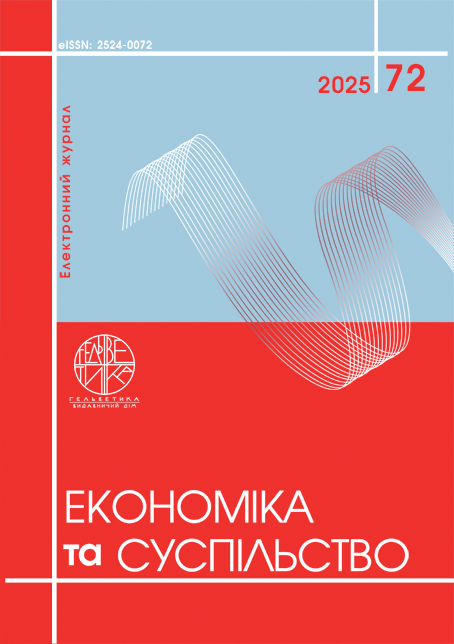ШТУЧНИЙ ІНТЕЛЕКТ ТА ГЛОБАЛЬНА НЕРІВНІСТЬ: НОВІ ВИКЛИКИ ДЛЯ РОЗПОДІЛЬЧИХ ВІДНОСИН
Анотація
Досліджено вплив штучного інтелекту (ШІ) як складової технологічної екосистеми на глобальну нерівність і розподільчі відносини в умовах трансформації господарських систем, що переходять до інформаційно-мережевої моделі. Встановлено, що автоматизація інтелектуальної праці, характерна для цього етапу, трансформує ринкову динаміку та суспільний продукт, змінюючи саму природу економічної взаємодії. ШІ підвищує продуктивність і економічні можливості, але поглиблює нерівність, обмежуючи людський капітал і створюючи диспропорції в доходах. Підкреслено потребу в інтегрованому підході, що поєднує економічну ефективність і соціальну справедливість як базові компоненти нової системи відтворення. Запропоновано переосмислення розподільчих відносин через інвестиції в освіту та базовий дохід для мінімізації ризиків і забезпечення соціально-економічної рівноваги в умовах загострення глобальної нерівності.
Посилання
Solow R.M. A contribution to the theory of economic growth // The Quarterly Journal of Economics. – 1956. – Vol. 70, № 1. – P. 65–94.
Brynjolfsson E., McAfee A. The second machine age: Work, progress, and prosperity in a time of brilliant technologies. – New York : W. W. Norton & Company, 2014. – 281 p.
Frey C.B., Osborne M.A. The future of employment: How susceptible are jobs to computerisation // Technological Forecasting and Social Change. – 2017. – Vol. 114. – P. 254–280.
Acemoğlu D., Johnson S. Rebalancing AI // Finance & Development Magazine. – 2023. – December. – Режим доступу: https://www.imf.org/en/Publications/fandd/issues/2023/12/Rebalancing-AI-Acemoglu-Johnson (дата звернення: 10.01.2025).
Autor D.H. Why are there still so many jobs? The history and future of workplace automation // Journal of Economic Perspectives. – 2015. – Vol. 29, № 3. – P. 3–30.
Newell A., Simon H. The logic theory machine — a complex information processing system // IRE Transactions on Information Theory. – 1956. – Vol. 2, № 3. – P. 61–79. – DOI: https://doi.org/10.1109/TIT.1956.1056797.
The economics of artificial intelligence: an agenda / за ред. A. Agrawal, J. Gans, A. Goldfarb. – Chicago : University of Chicago Press, 2019. – 629 p.
Гриценко А.А., Песоцька Є.І. Формування інформаційно-мережевої економіки // Економічна теорія. – 2013. – № 1. – С. 5–19. – Режим доступу: http://nbuv.gov.ua/UJRN/ecte_2013_1_2 (дата звернення: 10.01.2025).
Acemoglu D., Restrepo P. The wrong kind of AI? Artificial intelligence and the future of labor demand. – NBER Working Paper No. 25682. – Cambridge, MA : National Bureau of Economic Research, 2019. – 42 p. – Режим доступу: https://www.nber.org/papers/w25682 (дата звернення: 12.01.2025).
Шевченко А. Стратегія розвитку штучного інтелекту в Україні : монографія. – Київ : ІПШІ, 2023. – 305 с.
Hui X., Reshef O., Zhou L. The short-term effects of generative artificial intelligence on employment: Evidence from an online labor market. – 2023. – Режим доступу: https://papers.ssrn.com/sol3/papers.cfm?abstract_id=4527336 (дата звернення: 12.01.2025).
Cazzaniga M., Jaumotte F., Li L., Melina G., Panton A.J., Pizzinelli C., Rockall E., Tavares M.M. Gen-AI: Artificial Intelligence and the Future of Work : IMF Staff Discussion Note SDN/2024/001, Jan. 2024 / International Monetary Fund. – Washington, D.C. : IMF, 2024. – 41 p. – Режим доступу: https://www.imf.org/en/Publications/Staff-Discussion-Notes/Issues/2024/01/08/Gen-AI-Artificial-Intelligence-and-the-Future-of-Work-539471 (дата звернення: 14.01.2025).
Generative AI could raise global GDP by 7 percent / Goldman Sachs. – Goldman Sachs, 2023. – Режим доступу: https://www.goldmansachs.com/insights/articles/generative-ai-could-raise-global-gdp-by-7-percent (дата звернення: 14.01.2025).
Min A. Artificial intelligence and bias: challenges, implications, and remedies // Journal of Social Research. – 2023. – № 2 (11). – P. 3808–3817.
Державна служба статистики України. Офіційний сайт. – Режим доступу: https://www.ukrstat.gov.ua/ (дата звернення: 16.01.2025).
Пікетті Т. Капітал у XXI столітті / пер. з англ. Н. Палій. – Київ : Наш Формат, 2016. – 696 с.
Sen A. Development as freedom. – New York : Alfred A. Knopf, 1999. – 366 p.
Oxfam International. Inequality Inc.: how corporate power divides our world and the need for a new era of public action. – Oxford : Oxfam GB, 2024. – 55 p. – DOI: https://doi.org/10.21201/2024.000007.
Romer P.M. Endogenous technological change // The Journal of Political Economy. – 1990. – Vol. 98, № 5, Part 2. – P. S71–S102.
Гриценко А.А. Економіко-інформаційний імператив нової статистичної парадигми : монографія / А.А. Гриценко ; НАН України, ДУ «Ін-т екон. та прогнозув. НАН України». – Київ, 2020. – 436 с.
Solow R. M. (1956). A contribution to the theory of economic growth [A contribution to the theory of economic growth]. The Quarterly Journal of Economics, vol. 70(1), pp. 65–94.
Brynjolfsson E., McAfee A. (2014). The second machine age: Work, progress, and prosperity in a time of brilliant technologies. New York: W. W. Norton & Company, 281 p.
Frey C. B., Osborne M. A. (2017). The future of employment: How susceptible are jobs to computerisation. Technological Forecasting and Social Change, vol. 114, pp. 254–280.
Acemoğlu D., Johnson S. (2023). Rebalancing AI. Finance & Development Magazine, December. Available at: https://www.imf.org/en/Publications/fandd/issues/2023/12/Rebalancing-AI-Acemoglu-Johnson (accessed January 10, 2025).
Autor D. H. (2015). Why are there still so many jobs? The history and future of workplace automation. Journal of Economic Perspectives, vol. 29(3), pp. 3–30.
Newell A., Simon H. (1956). The logic theory machine — a complex information processing system. IRE Transactions on Information Theory, vol. 2(3), pp. 61–79. DOI: https://doi.org/10.1109/TIT.1956.1056797.
Agrawal A., Gans J., Goldfarb A. (Eds.). (2019). The economics of artificial intelligence: An agenda. Chicago: University of Chicago Press, 629 p.
Hrytsenko A. A., Pesotska Ye. I. (2013). Formuvannia informatsiino-merezhevoi ekonomiky [Formation of the informational-network economy]. Ekonomichna teoriia - Economic theory, no. 1, pp. 5–19. Available at: http://nbuv.gov.ua/UJRN/ecte_2013_1_2 (accessed January 10, 2025) (in Ukrainian).
Acemoglu D., Restrepo P. (2019). The wrong kind of AI? Artificial intelligence and the future of labor demand. Cambridge, MA: National Bureau of Economic Research, 42 p. Available at: https://www.nber.org/papers/w25682 (accessed January 12, 2025).
Shevchenko A. (2023). Stratehiia rozvytku shtuchnoho intelektu v Ukraini: Monohrafiia [AI development strategy in Ukraine: Monograph]. Kyiv: IPSHI, 305 p. (in Ukrainian).
Hui X., Reshef O., Zhou L. (2023). The short-term effects of generative artificial intelligence on employment: Evidence from an online labor market. Available at: https://papers.ssrn.com/sol3/papers.cfm?abstract_id=4527336 (accessed January 12, 2025).
Cazzaniga M., Jaumotte F., Li L., Melina G., Panton A. J., Pizzinelli C., Rockall E., Tavares M. M. (2024). Gen-AI: Artificial Intelligence and the Future of Work. Washington, D.C.: IMF, 41 p. Available at: https://www.imf.org/en/Publications/Staff-Discussion-Notes/Issues/2024/01/08/Gen-AI-Artificial-Intelligence-and-the-Future-of-Work-539471 (accessed January 14, 2025).
Goldman Sachs. (2023). Generative AI could raise global GDP by 7 percent. Available at: https://www.goldmansachs.com/insights/articles/generative-ai-could-raise-global-gdp-by-7-percent (accessed January 14, 2025).
Min A. (2023). Artificial intelligence and bias: challenges, implications, and remedies. Journal of Social Research, no. 2(11), pp. 3808–3817.
Derzhavna sluzhba statystyky Ukrainy [State Statistics Service of Ukraine]. (n.d.). Ofitsiinyi sait [Official website]. Available at: https://www.ukrstat.gov.ua/ (accessed January 16, 2025).
Piketty T. (2016). Kapital u XXI stolitti [Capital in the 21st Century]. Kyiv: Nash Format, 696 p. (in Ukrainian).
Sen A. (1999). Development as freedom. New York: Alfred A. Knopf, 366 p.
Oxfam International. (2024). Inequality Inc.: how corporate power divides our world and the need for a new era of public action. Oxford: Oxfam GB, 55 p. DOI: https://doi.org/10.21201/2024.000007.
Romer P. M. (1990). Endogenous technological change. The Journal of Political Economy, vol. 98(5, Part 2), pp. S71–S102.
Hrytsenko A. A. (2020). Ekonomiko-informatsiinyi imperatyv novoi statystychnoi paradyhmy: Monohrafiia [Economic-informational imperative of the new statistical paradigm: Monograph]. Kyiv: Institute for Economics and Forecasting NAS of Ukraine, 436 p. (in Ukrainian).

Ця робота ліцензується відповідно до Creative Commons Attribution 4.0 International License.


